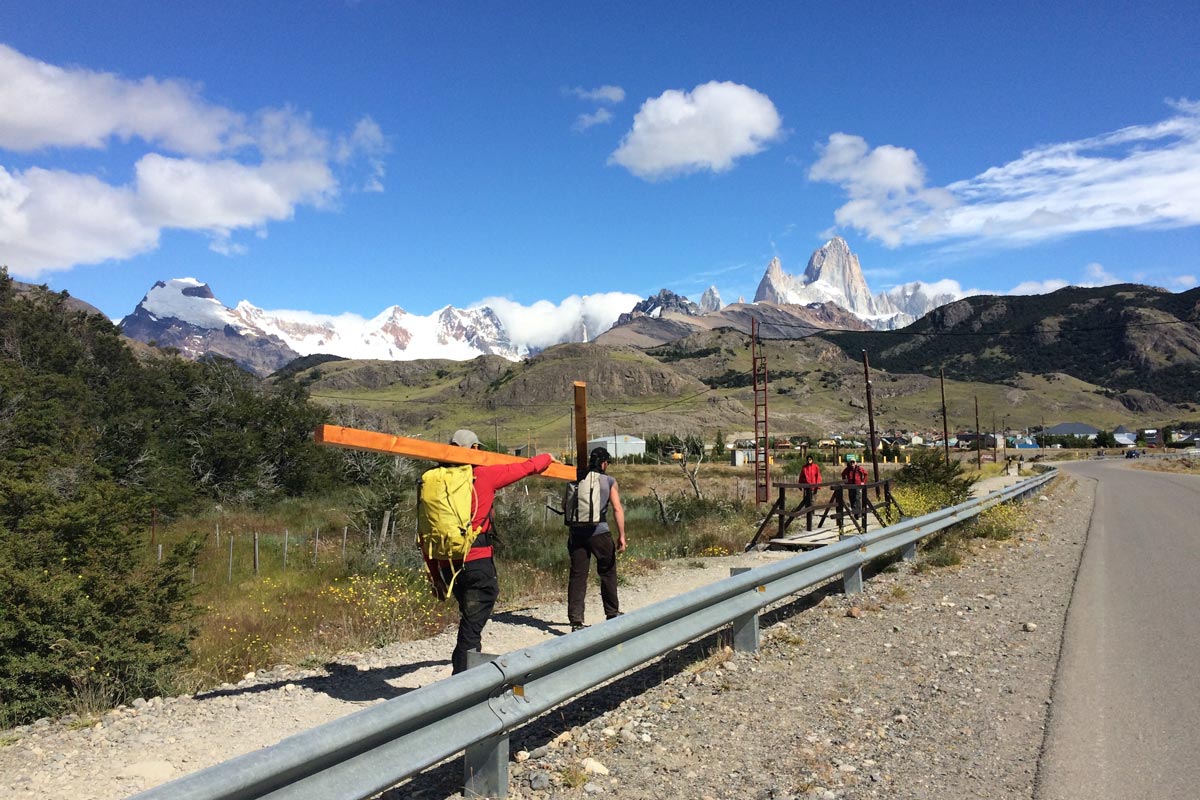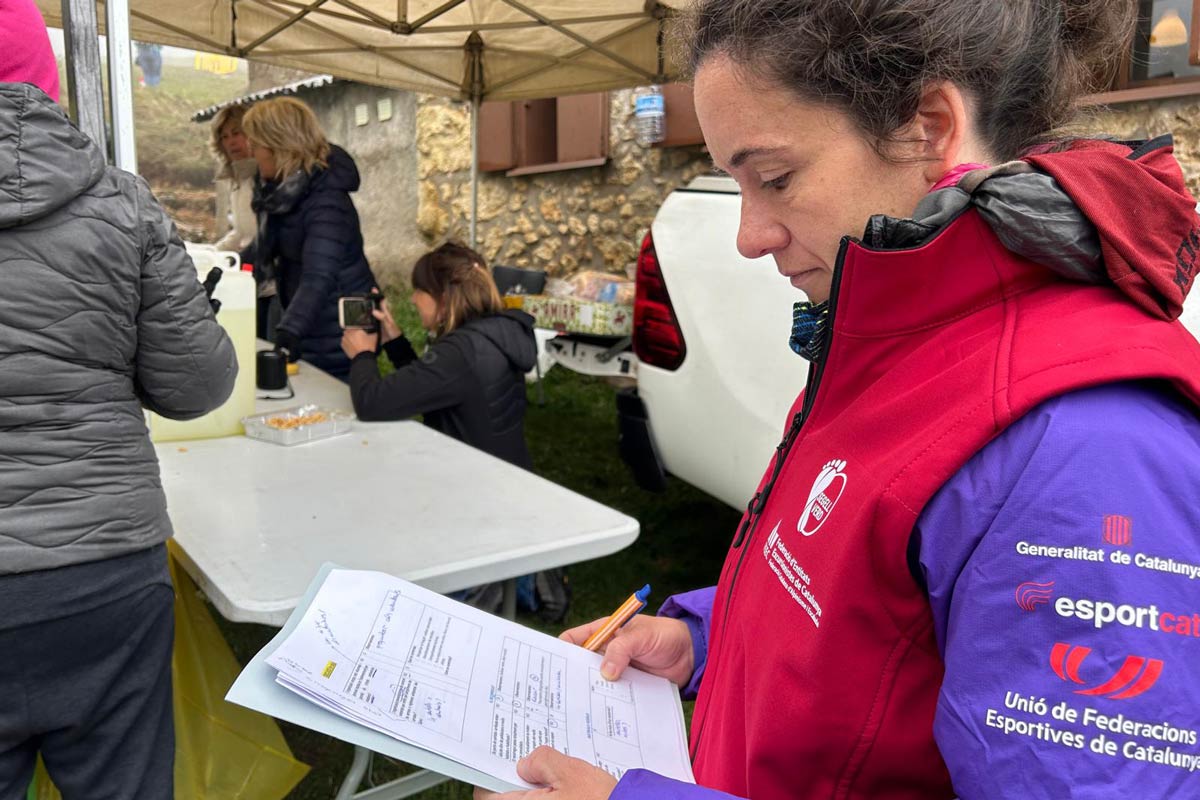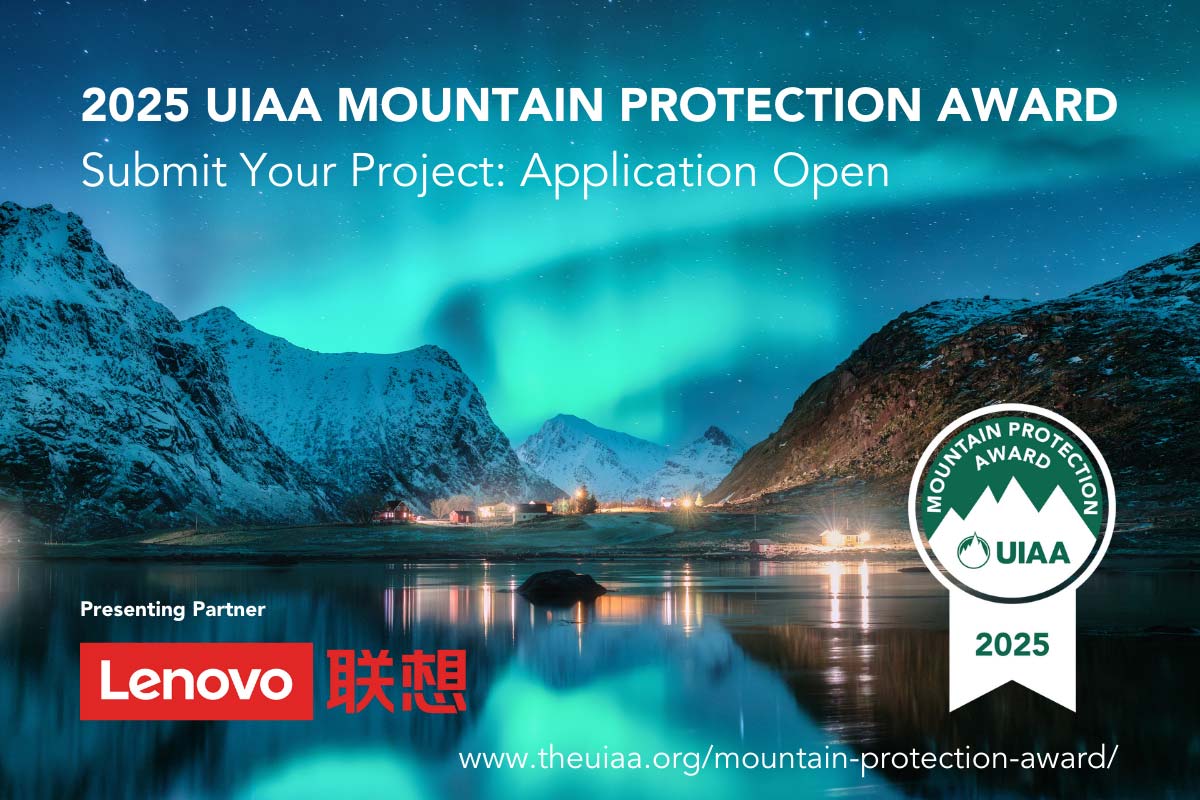2018 Nominee
RE-NOMINATION
Project Status: Ongoing, initial implementation, December 2015
Location: Argentina. Organisation: Brazil
Contact: Felipe Proano I
Email – Website – Instagram
GOALS AND OBJECTIVES
Our goal was to find simple, inexpensive options to manage human waste in base camps in locations that are remote, and have no septic systems or transport via helicopter sling loads. The longer term, permanent goal is to provide a healthier human experience in the mountains as well as improvement for the local environment by minimizing human waste and disposing of it properly.
The chosen location of the project was the Northern Sector of the Los Glaciares National Park, El Chaltén, Argentina, home to the inspiring Fitz Roy and Torre Ranges – a popular destination for climbers. The vertical alpine granite spires offer complex and remote routes as well as unpredictable weather and high challenges. In response to the development of the village as a tourism destination and the effectiveness of weather forecast, the number of climbers has been increasing in the past decade.
The number of climbers exploring the massif has grown considerably and waste management has become a necessity. Right now, the climbing basecamps’ waste management is non-existent. Many climbers are aware of minimum-impact waste disposal practices, and where applicable, dig cat holes. However, most of the camps are in glacier environments (dry glacier, moraines, and glacier), so cat holes are not always a possibility and human waste can’t break down properly. The lack of a waste management solution results in poor disposal methods or long-term cumulative effects, which has the potential to cause social and environmental impacts.
The Patagonia Waste Management project addresses this issue by proposing solutions that will provide a more sustainable and human experience as well as are economically feasible, low maintenance, and provide a long-term solution to the area, especially considering the park’s budget and personnel restrains.
Objectives of the first season (2015/16) – The Pilot-Study:
- To implement a vermicomposting toilet with an urine diversion system at Laguna Capri
- Manage the use and care of the toilet.
Objectives of the second season (Feb 2017)
- Evaluate the effectiveness of the test piece and
- Improve the use and care of the toilet.
- Promote more awareness about the project.
- Study the context of the Piedra Negra bivvy site.
Objectives of the third season (February 2018)
- Propose appropriate human waste management solutions for two climbing base camps in the El Chaltén Massif.
- Provide guidelines for the use and care for each area, considering its proposed management strategy.
- Establish guidelines to research the results of the proposed strategies.
RELATIONSHIP WITH LOCAL COMMUNITIES
El Chaltén is a young village that has seen a lot of growth in the last decade. In 2008 the dirt roads were paved; there is now over 20 lodging options areas, 15+ restaurants, three grocery stores, and easy road access; all in a town with around 1,500 inhabitants in peak season. Wifi internet has also reached town and brought along the easiness of forecast accessibility, allowing climbers to better plan their incursions.
The village depends on tourism that happens almost exclusively during the summer. The incredible granite spires of the Fitz Roy and Torre Massifs attract tourists from all over the world in search of adventure along the hiking trails or climbing routes. Climbing in the area has happened since the 1910s. In fact, the town breathes the climbing spirits, with world-class climbers doing incredible feats and climbing guides settling in the area for making a living.
The Patagonia Waste Management project promotes healthier experiences for climbers and hikers alike in the mountains for both local and out-of-town adventurers. By doing so, it directly benefits and reinforces the touristic identity of El Chaltén, helping to attract more tourists, who get to experience a more humane experience in the mountains.
By giving voice to the local community through meetings and planning, the project empowers them to take care of the mountains, which is at the same time their backyard, their source of income, and their inspiration. Through an outreach program, the project educates locals about human waste management in remote location, and stimulates local guides and climbers to be stewards of the park. In fact, a local guide has become the spokesperson of the project while the US volunteers are away.
The project also has had the opportunity to work closely with the park administration, involving them in the planning and management process. The interaction with the park has the potential to improve the relationship between the park staff and local guides and climbers by exchanging different points of view about the same issue while also constructing the knowledge and awareness about waste management. At the same time, the project promoted a few training sessions with the park staff so they could critically analyze and take care of the units or management solutions.
At last, this project benefits the local communities by potentially increasing water quality in the surrounding areas, which also increases the user experience. These are some of the most iconic mountains on earth and there imminent care is a necessity.
COLLABORATION WITH LOCAL AUTHORITIES
The project is the result of the collaboration between different organizations and people.
Access PanAm and the volunteers work directly with the Argentinean National Park Agency (Administración de Parques Nacional, APN) to coordinate logistics of this project. During the three years of the project, this became an established and good relationship. APN has provided housing and portering support during the first year of the project. The use of their wood shop was essential to the construction of the test piece. Their intimate knowledge about visitation issues in the area contributed decisively to the planning process.
The Park has carried out a throughout study about the worms found in the local site of the pilot study, which concluded that they were native species to the park. Therefore, we were able to add worms to the fecal pile on the second season, which will accelerate decomposition. Ultimately, the Park management is also responsible for maintaining the unit.
Access PanAm has a partnership with Toilet Tech to offer the best solutions concerning waste management. Dr. Geoff Hill, director of Toilet Tech, has a Phd. from the University of British Columbia in waterless human waste management in 2013. He has been inside dozens of waterless toilets throughout the world and knows intimately what makes a toilet work well (urine diversion) and what makes a toilet smell and fail (urine mixed with fecal matter). He provides key consultation and solutions for the project.
BEYOND BUSINESS AS USUAL AND CONSIDERATIONS FOR MOUNTAINEERING AND MOUNTAIN-BASED SPORTS
This project proposes human waste management solutions to the Patagonia region by analyzing different visitation aspects and environmental contexts in one of the most iconic areas of the planet.
The caliber of science behind the toilet comes from one of the most highly regarded Doctors of waterless human waste management in North America, Dr. Geoff Hill from Toilet Tech His participation in the project contributes to the solutions and recommendations based on about 10 years of experience in the theme.
Another aspect of the project that differentiates itself from others and is at the same time an example of best practice is the dedication of several volunteers, who managed to construct a toilet structure measuring 2.5×2.5×3.6 meters 4 km from town – mainly 4-6 people working full time for 55 days with some extra volunteers helping for a few days. The extreme dedication of volunteers is one of the aspects that make this project unique. Working with volunteers is not on itself an innovation, but the amount of the dedication and involvement has certainly gone beyond business as usual. The level of attention to detail and caliber of crew is far beyond “business as usual.” As an example, the Project Manager, Steffan Gregory, has dedicated over 2.000 hours for the project since 2015.
Access PanAm is also quite unique – this non-profit organization was created in 2009 by inspiration of one of the most experienced mountain access and conservation advocate in the USA, Armando Menocal, who was also a founding member of North America’s Access Fund. Access PanAm’s deep knowledge in South America has contributed decisively to success of the project.
One of the mayor issues concerning visitation in protected areas nowadays is human waste. The proposal of solutions to deal with this issue in popular and remote backcountry base camps contributes to protecting the mountain environment, while at the same time promoting users education and empowerment.
PROJECT MANAGEMENT
The project is managed by the Patagonia Waste Management Project Manager, Steffan Gregory with the support of Access PanAm’s Executive Director, Kika Bradford. They are both responsible for fundraising and managing funds for the project, making decisions together about how to invest the resources we have in the project.
During the first season, Alan Thorne, a climber, guide, NOLS instructor and carpenter was the person responsible for the designing and implementing the toilet structure. He also trained and supervised our volunteers during the construction.
Rachel Mangan and Ethan Newman we’re critical in supporting the project at every juncture. Rachel’s’ Bachelor’s’ degree in Environmental Science Resource management gave her keen attention to detail. Whether it was hands on construction or presenting the project to the National park in a foreign language, Rachel dotted all of the I’s and crossed of the T’s all the way through. Ethan Newman’s’ background in outdoor education and dedication to two seasons of on the ground work allowed the project to persist. His ability to think outside the box, create a fun work environment kept morale high and quality higher.
Milestones and Timeframe:
First season (Dec 2015 – Mar 2016):
- Purchase of materials
- Training of volunteers
- Construction of the test toilet at Laguna Capri
- Training of Park staff
- Outreach program: meetings with park staff, park volunteers, and local climbers
Second season (Feb 2017):
- Maintenance of the Laguna Capri unit
- Collection of data from the Laguna Capri unit
- Training of park staff and volunteers
- Training of volunteers
- Coordination with the Argentinean National Park Agency to facilitate importing of the toilets
- Outreach program: meetings with park staff, local climbers
- Involvement and empowerment of locals to act as stewards
- Analysis of Piedra Negra bivvy campsite
- Production of assessment and guidelines document
Third season (Feb 2018):
- Maintenance of the Laguna Capri unit
- Training of park staff and volunteers
- Outreach program: meetings with park staff, local climbers
- Involvement and empowerment of locals to act as stewards
- Implementation of the Waste management solution at the Piedra Negra bivvy campsite
- Production of assessment and guidelines document
OPPORTUNITIES FOR VOLUNTEERS
The project only could happen through the work and dedication of many volunteers. Besides the Project Manager, three other full-time volunteers dedicated over 400 hours each to the project, including the lead carpenter during the first season. The second season had three dedicated volunteers and two full-time volunteers took part of the third season. Furthermore, over 10 volunteers have helped in different aspects of the project, from planning and fundraising to actually building the test piece.
The outreach actions of the project have also helped to promote stewardship in the mountains, especially among locals. Participatory meetings, presentations, and the involvement of the local climbers have promoted more debate and awareness about the issue. Paula Chapporro, a Chaltén local and passionate activist has donated weeks of her time to helping this project continue. Paula is dedicated to the betterment of the park as well as the relationship the town has the to park. She has guided in the area, taught children’s programs and built homes. Her wide skill set and kindness have empowered all involved.
This project supports stewardship in mountain ranges by incorporating the local community of El Chaltén to become involved with waste management in the park. The national park in this area is understaffed and will need support in order for the project to continue to succeed. In this past year the guides association in El Chaltén offered their support and is the start of a larger community backing beyond the national park. This project is just the beginning of waste management in the area and the possibilities for future stewardship are endless.
HOW WE COMMUNICATE
The communication strategy incorporated different aspects according to the target audience.
Wi-fi Internet is a recent reality in El Chaltén and it is still very limited, so the dissemination of the project’s activities for EL Chaltnén townspeople and Park staff focused on oral presentations and meetings. The first year of the project included one participatory meeting the townfolks, climbers, and guides, one presentation for the Park volunteers, meetings with local guides and the climbing club, and several meetings with the Park officials. The second and third years continued to explore that venue.
In the United States, Steffan Gregory has held 6 presentations about the project to disseminate the experience and results. Furthermore, he has also scheduled presentations at sponsors’ headquarters so as to involve the companies’ staff in the discussion of waste management issues, the project and its results.
As for our online presence, during the three years of the project, the dissemination of the project’s activities was centered around Acceso PanAm’s communication media: website, Facebook and Instagram. Recently, the project has gained its own communication channels: a website (patagoniawastemanagement.com) and an (Instagram instagram.com/patagoniawastemanagement)
The website is being updated with more information month by month. The instagram is updated and is a great place to stay connected to the happenings with Patagonia Waste Management. Feel free to share both of these pages to encourage awareness of the project.
RETURN TO UIAA MOUNTAIN PROTECTION AWARD PROJECT PAGE



